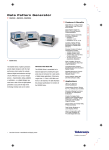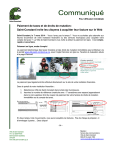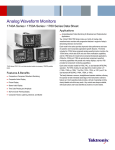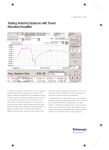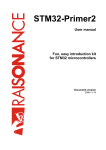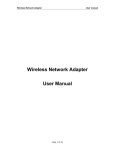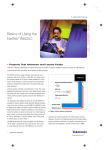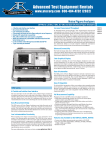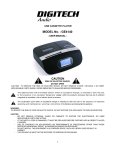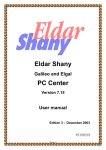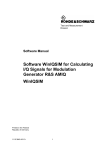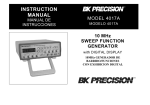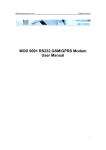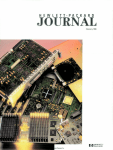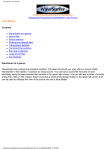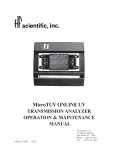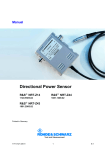Download Tektronix 3066,3086 Real-Time Spectrum
Transcript
3066 • 3086 R e a l -Ti m e S p e c t r u m A n a ly z e r s Features and Benefits Seamless Acquisition for Capture of Short Duration or Intermittent Events Analyzes in Frequency, Time and Modulation Domain Applications 1st, 2nd, and 3rd Generation Cellular/PCS R&D – Including GSM, CDMA, IS-136, PDC, W-CDMA Signature Analysis DC to 3 GHz Coverage Spectrum Monitoring Frequency Event Trigger for Acquisition of Burst or Infrequently Occurring Signals Settling Time Measurements for Oscillators and Synthesizers Post Capture 1000:1 Zoom Allows Analysis of Individual Signals After Wideband Capture Debugging of Hardware/Software Interface Problems Phase Hit Capture and Measurement Code Domain Power and Complementary Cumulative Distribution Function (CCDF) for IS-95, W-CDMA Signals CCDF for Multi-carrier and W-CDMA Signals The 3066 and 3086 are DC to 3 GHz real-time spectrum analyzers that allow the seamless capture of frequency spectra with spans up to 30 MHz (5 MHz – 3066). This allows the spectrum of burst signals, such as those from GSM, IS-136, PDC or partial rate CDMA mobile stations, to be easily captured and examined. Real-time spectrum analyzers take a very different approach compared to traditional sweeping spectrum analyzers. Rather than acquiring one frequency step at a time, the real-time instrument captures a block of frequencies all at once. Because the instrument samples these full frames constantly (rather than waiting for each discrete frequency step to be measured), the signal can come or go as it pleases and the real-time spectrum analyzer will detect the change instantly. The 12.1 in. color TFT display allows easy viewing of spectrum, waterfall displays, spectrograms and digital modulation analysis screens. Constellation and vector diagrams can be displayed, as well as frequency, phase, magnitude, I and Q versus time, for in-depth analysis of digitally modulated signals. Users can move a marker through the time record and analyze the modulation at any point. In particular, signals with symbol rates up to 20.48 Msymbols/sec (3066 – 5.3 Msymbols/sec) may be analyzed during and after capture. This facilitates analysis of W-CDMA signals with chip rates up to 16.384 Mcps. ® Option 16: IS-95 and W- CDMA Code Domain Power for the 3086 3086 In addition, a frequency mask trigger allows capture of randomly occurring or infrequent signals such as intermittent spurious emissions. If the user is not interested in the period between transmission bursts, the frequency mask trigger allows capture of the “burst-on” periods, thus maximizing the number of bursts that can be captured in memory for subsequent spectral, time or modulation analysis. The user can graphically define the frequency trigger mask; this allows the trigger condition to be generated by a particular event in the frequency domain irrespective of other activity within the displayed span. This is a major benefit when the trigger condition is used to capture signals arising from intermittent spurious or spectral re-growth events. Option 1S, automatic waveform recording, can be used to store multiple memory blocks to the internal hard drive without operator intervention. This enables unattended monitoring and recording of transient events for later review. A 1000:1 zoom capability permits analysis to be performed on an individual signal in a multi-signal environment. 2 CDMA and W-CDMA Base Station developers use code domain power measurements to verify correct operation of their designs. BTS amplifier designers rely upon Complementary Cumulative Distribution Functions (CCDF) to verify the input and output amplitude distributions of their test waveforms. When equipped with options 16 and 20, the 3086 now meets these needs for IS-95 and W-CDMA designs. The real-time nature of the 3086 spectrum analyzer brings unique advantages to this application. The 3086 with option 16 processes the WCDMA down-link signals as defined in “Specifications for W-CDMA Mobile Communication System Experiment Version 1.1” and offers extensive analysis capability including: Code-domain power The analyzer measures the relative power to total power for each channel with 1024 channels maximum Time vs. code-domain power The analyzer measures the relative power at symbol points for each channel as a time series Code-domain power spectrogram The analyzer measures the codedomain power continuously for maximum 160 slots (0.1 s) and displays spectrogram for each slot Modulation accuracy The analyzer measures EVM (error vector magnitude), amplitude error, phase error, waveform quality, and origin offset for each channel For customers who need code domain analysis of IS-95 base station signals, option 16 also provides code power measurements for IS-95 signals over a 6144 symbol period. 3066 • 3086 Option 20 CCDF (3066 and 3086) Feature Summary Option 20 records the statistical nature of a signal, and plots the probability of exceeding a measured average value for the waveform. A large amount of data is collected in the memory of the 3086, and Complementary Cumulative Distribution Function (CCDF) can be shown over selected periods of time to determine the effect of code selection or multi-carrier additions on the peak-to-average ratio of the waveform. Base station amplifier designers use this information to judge the distortion performance of their products. The rapid changes that occur in base station power outputs require a real-time bandwidth higher than the occupied bandwidth of the signals measured. The 3086 provides unique capability due to its 30 MHz real-time bandwidth, allowing CCDF measurements on up to 6 W-CDMA carriers simultaneously. In the 3066, CCDF measurements over a 5 MHz realtime bandwidth is possible. Option 15: IS-95 Code Domain Power for the 3066 Spectrum Analyzer OPTION 15 (3066) FEATURE SUMMARY: Option 15 offers the measurement functions listed below: Code-domain power Measures the relative code power to total power for each channel Code-domain power vs. Time (codegram) The analyzer measures the codedomain power continuously for 6144 symbols (0.32 s) maximum and displays spectrogram for each symbol Modulation accuracy and vector display Measures EVM (error vector magnitude), amplitude error, phase error, waveform quality, and origin offset for all signals REAL-TIME SPECTRUM A N A LY Z E R S Characteristics INPUT/MEMORY MODE RELATED Input Mode – RF, Baseband; Wideband, IQ (3086 only). Input Connector – N type (RF, Baseband, Wideband), BNC type (IQ). Input Impedance – 50 Ω. VSWR (N type) – 1.5 (Reference Level ≥-20 dBm). Acquisition Mode – Roll, Block. Acquisition Memory Size – 16 Mbytes. Acquisition Memory Management – RF, Baseband Input. Memory Mode: Frequency, Dual, Zoom. FFT Points: 1024, 256 (Frequency Mode). FFT Window: Rectangular, Hamming, Blackman-Harris. Block Size: 1 to 16,000 Frames (Frequency Mode, 256 pt). 1 to 4,000 Frames (Frequency Mode, 1024 pt). 1 to 2,000 Frames (Dual, Zoom Mode). BASEBAND INPUT RELATED Minimum Frame Update Time: 20 µs (Frequency Mode, 256 pt). 80 µs (Frequency Mode, 1024 pt). 160 µs (Dual, Zoom Mode). Wideband, IQ Input (3086 only) – Memory Mode: Zoom. FFT Points: 1024. FFT Window: Rectangular, Hamming, Blackman-Harris. Block Size: 1 to 2,000 Frames. Minimum Frame: 25 µs. F r e q u e n c y Sta n d a r d R e l at e d Characteristic Reference frequency Initial frequency tolerance Frequency stability Aging Temperature Description 10 MHz ± 0.1 ppm ±0.0005 ppm/day ±0.002 ppm (5 to 40°C) RF INPUT RELATED Frequency – Range: 10 MHz to 3 GHz. Center Frequency Settability: 0.1 Hz. Span: 100 Hz to 3 GHz. Vector Span: 100 Hz to 6 MHz. Real-time Span: 100 Hz to 5 MHz. Number of Bins: 641 (100 Hz to 2 MHz span). 801 (5 MHz span). 481 (6 MHz span). Span/6250 + 1 (span ≥ 10 MHz). Spectrum Purity: –100 dBc/Hz (1 GHz CF, 200 kHz span, 0 dBm ref, 10 kHz offset). Residual FM: 3 Hz p-p. 3066 • 3086 REAL-TIME Amplitude – Reference Level: –50 dBm to +30 dBm. Maximum Nondestructive Input Power: +30 dBm. Self Gain-Calibration Accuracy: ±1.0 dB at 25 MHz within 5°C temperature variation. Flatness: ±2.0 dB (10 MHz to 3 GHz). Input Equivalent Noise: –140 dBm/Hz. 3rd Order Distortion: –65 dBc (–10 dBfs input, at 1 GHz). Residual Response: –70 dBfs (0 dBm ref, 5 MHz span). Image Suppression: 70 dB. Spurious Free Dynamic Range (1 GHz CF, 0 dBm REF, sinusoidal signal at the center, spur apart more than 10 kHz from the signal): 80 dB at 50 kHz span. 75 dB at 100 kHz span. 70 dB at 200 kHz and 500 kHz span. 65 dB at 1/2/5 MHz span. Frequency – Range: DC to 10 MHz. Center Frequency Settability: 0.1 Hz. Span: 100 Hz to 10 MHz. Vector Span: 100 Hz to 6 MHz. Real-time Span: 100 Hz to 5 MHz. Number of Bins: 641 (100 Hz to 2 MHz span). 801 (5 MHz and 10 MHz span). 481 (6 MHz span). Spectrum Purity: –100 dBc/Hz (5 MHz CF, 200 kHz span, 0 dBm ref, 10 kHz offset). Residual FM: 2 Hz p-p. Amplitude – Reference Level: –30 dBm to +30 dBm. Maximum Nondestructive Input Power: +30 dBm. Reference Level Accuracy: ±0.5 dB at 5 MHz. Flatness: ±1.0 dB (1 MHz to 10 MHz). Input Equivalent Noise: –150 dBm/Hz. 2nd Harmonic Distortion: –70 dBc (at 4.5 MHz). DC Offset: –40 dBfs. Residual Response: –70 dBfs (5 MHz CF, 5 MHz span, 0 dBm ref). Alias Suppression: 65 dB. Spurious Free Dynamic Range (5 MHz CF, 0 dBm ref, sinusoidal signal at the center, spur apart more than 10 kHz from the signal): 85 dB at 50 kHz span. 80 dB at 100 kHz span. 75 dB at 200 kHz span. 70 dB at 500 kHz span. 70 dB at 1/2/5 MHz span. SPECTRUM A N A LY Z E R S WIDEBAND INPUT RELATED (3086 ONLY) Frequency – Range: 50 MHz to 3 GHz. Center Frequency Settability: 0.1 Hz. Span: 10 MHz, 20 MHz, 30 MHz. Vector Span: 10 MHz, 20 MHz, 30 MHz. Number of Bins: 501 (10 MHz and 20 MHz span). 751 (30 MHz span). Amplitude – Reference Level: –50 dBm to +30 dBm. Maximum Nondestructive Input Power: +30 dBm. Flatness within Span: ±1 dB (25°C ±5°C). Input Equivalent Noise: –140 dBm/Hz. 3rd Order Distortion: –65 dBc (–10 dBfs input, at 1 GHz). Residual Response: –60 dBfs (0 dBm ref, 30 MHz span). Image Suppression: 70 dB. Spurious Free Dynamic Range (1 GHz CF, 0 dBm ref, sinusoidal signal at the center, spur apart more than 500 kHz from the signal): 65 dB at 10 MHz span. 60 dB at 20 MHz and 30 MHz span. IQ INPUT RELATED (3086 ONLY) Frequency – Range: ±15 MHz. Span: 10 MHz, 20 MHz, 30 MHz. Vector Span: 10 MHz, 20 MHz, 30 MHz. Number of Bins: 501 (10 MHz and 20 MHz span). 751 (30 MHz span). Amplitude – Reference Level: 100 mV (amplitude of IQ signal). Maximum Nondestructive Input Power: ±5 V. Flatness within Span: ±0.5 dB (25°C ±5°C). Residual Response: –60 dBfs (30 MHz span). Alias Suppression: 55 dB. Spurious free dynamic range (1 GHz CF, 0 dBm ref, sinusoidal signal at the center, spur apart more than 500 kHz from the signal): 65 dB at 10 MHz span. 60 dB at 20 MHz and 30 MHz span. 3 Characteristics FRAME TIME RELATED M i n i m u m F r a m e U p d at e Ti m e TRIGGER RELATED F r a m e Ti m e ( 3 0 8 6 ) Span Trigger Mode – Auto, Normal, Quick, Delayed, Interval, Quick-interval, Timeout, Auto, Normal [RF (span ≤ 6 MHz) and Baseband Input, Wideband and IQ Input (3086 only)]. Trigger Source – Internal/External. Trigger Domain – Frequency, Time. Trigger Position – 0 to 100%. Frequency Trigger Mask – Frequency Resolution: 1 bin. Trigger Level Range: 0 dBfs to –70 dBfs. Time Trigger Mask – Time Resolution: 1 data point. Trigger Level Range: 0 dBfs to –40 dBfs. External Trigger Threshold Level – 1.6 V. Span 1024 point Baseband Mode: 10 MHz 80 µs RF Mode and Baseband Mode: 6 MHz 80 µs 5 MHz 160 µs 2 MHz 320 µs 1 MHz 640 µs 500 kHz 1280 µs 200 kHz 3200 µs 100 kHz 6.4 ms 50 kHz 12.8 ms 20 kHz 32 ms 10 kHz 64 ms 5 kHz 128 ms 2 kHz 320 ms 1 kHz 640 ms 500 Hz 1280 ms 200 Hz 3200 ms 100 Hz 6400 ms Wideband/IQ Input Modes: 3086 Only 30 MHz 25 µs 20 MHz 25 µs 10 MHz 50 µs 4 256 point 20 µs 20 µs 40 µs 80 µs 160 µs 320 µs 800 µs 1.6 ms 3.2 ms 8 ms 16 ms 32 ms 80 ms 160 ms 320 ms 800 ms 1600 ms 25 µs 25 µs 50 µs 1024 point 256 point FFT FFT Baseband/Frequency Mode 10 MHz 80 µs 20 µs RF/Baseband/Frequency Mode 500 kHz to 6 MHz 80 µs 20 µs 50 kHz to 500 kHz 200 µs 50 µs 5 kHz to 20 kHz 2000 µs 500 µs 500 Hz to 2 kHz 20 ms 5 ms 200 Hz 50 ms 12.5 ms 100 Hz 100 ms 25 ms RF/Baseband/Dual Mode 500 kHz to 6 MHz 160 µs N/A 50 kHz to 500 kHz 400 µs N/A 5 kHz to 20 kHz 4 ms N/A 500 Hz to 2 kHz 40 ms N/A 200 Hz 100 ms N/A 100 Hz 200 ms N/A RF/Baseband/Zoom Modes 5 MHz 160 µs N/A 2 MHz 320 µs N/A 1 MHz 640 µs N/A 500 kHz 1.28 ms N/A 200 kHz 3.2 ms N/A 100 kHz 6.4 ms N/A 50 kHz 12.8 ms N/A 20 kHz 32 ms N/A 10 kHz 64 ms N/A 5 kHz 128 ms N/A 2 kHz 320 ms N/A 1 kHz 640 ms N/A 500 Hz 1280 ms N/A 200 Hz 3200 ms N/A 100 Hz 6400 ms N/A Wideband/IQ Input Modes – 3086 Only 30 MHz 25 µs N/A 20 MHz 25 µs N/A 10 MHz 50 µs N/A 3066 • 3086 DISPLAY/VIEW Data Display – Waveform: Frequency vs. Amplitude/Phase. Frequency vs. I/Q voltage. Time vs. Amplitude/Phase. Time vs. I/Q voltage. Spectrogram: Time vs. Frequency vs. Amplitude/Phase. Waterfall: Time vs. Frequency vs. Amplitude/Phase. Time vs. Frequency vs. I/Q Voltage. Time vs. Amplitude/Phase Multi-Frame. Time vs. I/Q Voltage Multi-Frame. AM Demodulation: Time vs. Modulation depth. FM Demodulation: Time vs. Frequency deviation. PM Demodulation: Time vs. Phase deviation. FSK Demodulation: Time vs. Frequency deviation. Polar: Vector diagram, Constellation diagram. Eye Pattern: I, Q, Trellis. Symbol Table: Binary, Octal, Hexadecimal. Error Vector: EVM, Magnitude error, Phase error, Waveform quality (ρ). View – Number of Views: 1, 2, 4. Settable Views: 8 maximum. Display Traces: 2 on waveform display. LCD Panel – Size: 12.1 inch. Display Resolution: 1024 x 768 pixels. Color: 256 color (maximum). REAL-TIME SPECTRUM A N A LY Z E R S Characteristics DIGITAL DEMODULATION RELATED EMC COMPLIANCE D i g i ta l D e m o d u l at i o n R e l at e d Characteristic Demodulator Carrier type Modulation format Measurement filter Reference filter Filter parameter Maximum symbol rate Standard setup Display format Vector diagram Constellation diagram Eye diagram Error vector diagram Symbol table Error measurement accuracy PDC PHS GSM IS-95 reverse link QPSK, 4.096 Msps, 2 GHz QPSK, 16.384 Msps, 2 GHz Description Continuous, Burst BPSK, QPSK, π/4 Shift DQPSK, 8PSK, OQPSK, 16QAM, 64QAM, GMSK Root Cosine Cosine, Gauss α/BT: 0.0001 to 1, 0.0001 step 5.3 Msps (RF, Baseband); 20.48 Msps (Wideband, IQ; the 3086 only) PDC, PHS, NADC, TETRA, GSM, CDPD, IS-95, T-53 Symbol/locus display, Frequency error measurement, Origin offset measurement Symbol display, Frequency error measurement, Origin offset measurement I/Q/Trellis display (1 to 16 symbols) EVM, Magnitude error, Phase error, Waveform quality (ρ) measurement Binary, Octal, Hexadecimal 10 frames averaged EVM <1.2%, Mag error <1.0%, Phase error <0.8° (100 kHz span) EVM <1.4%, Mag error <1.2%, Phase error <0.8° (1 MHz span) EVM <1.8%, Mag error <1.2%, Phase error <1.0° (1 MHz span) EVM <2.0% (5 MHz span) EVM <2.5% (20 MHz span) EVM <3.0% (30 MHz span, 25°C ±5°C) MARKER ZOOM RELATED ENVIRONMENTAL Marker – Marker Type: Normal, Delta, Band-Power. Search Function: Peak Right, Peak Left, Maximum. Link between Views: On/Off. Measurement Function – Noise Power, Power within Band, C/N, Adjacent Channel Power, Occupied Bandwidth. Digital Zoom – Zoom Ratio: 2 to 1000. Maximum Span in the Zoom Mode: 5 MHz (RF, Baseband), 30 MHz (Wideband, IQ, 3086 only). Temperature Range – Operating: +5 to +40°C (floppy not used), +10 to +40°C (floppy used). Nonoperating: –20 to +60°C. Humidity – Operating and nonoperating: 80% non-condensing. Maximum wet-bulb temperature 29°C. Altitude – Operating: Up to 2,000 m (6,500 ft). Nonoperating: Up to 12,000 m (40,000 ft). Random Vibration – Operating: 0.27 g, 5 to 500 Hz, 10 minutes each axis. Nonoperating: 2.28 g, 5 to 500 Hz, 10 minutes each axis. Shock – Nonoperating: 20 g half-sine, 11 ms duration, 3 shocks per axis in each direction (18 shocks total). Package Product – Vibration and Bounce: Meets ASTM D999-75, Method A, Para. 3.1g, (NSTA proj. 1-A-B-1). Drop: Meets ASTM D775-61, Method 1, Para. 5, (NSTA proj. 1-A-B-2). SYSTEM CONTROLLER Pentium MMX 200 MHz, 64 Mbyte SIMM, Windows 95, PCI, ISA, TMP68301 16 MHz, 2.1 Gbyte 3.5 inch EIDE, 1.44 Mbyte floppy drive, GPIB IEEE488.1, Keyboard PC/AT. (order separately), Centronics parallel port, SCSI 2. 3066 • 3086 REAL-TIME SPECTRUM A N A LY Z E R S Emissions – Enclosure: EN55011 Class A, limits for radiated emissions. AC Main: EN61000-3-2 Power line harmonics; EN55011 Class A, limits for radiated emissions. Immunity – Enclosure: EN61000-4-2 ESD (Up to 8 kV, 150 pF through 330 Ω) Internal terminals of connectors do not allow ESD test. AC Main: EN61000-4-3 Radiation; EN61000-4-4 Fast Transient Burst; EN61000-4-5 Surge; EN61000-4-6 Conductive Immunity. SAFETY Safety – UL3111-1, CSA231, EN61010-1, IEC61010-1. POWER Line Voltage – 100 to 240 VAC Nominal. Line Frequency – 47 Hz to 66 Hz. Line Fuse – 10 A, fast. Primary Circuit Dielectric Voltage Withstand Grounding Impedance – 1,500 Vrms, 50 Hz for 15 s, without breakdown. Verify continuity of grounding connection, by any suitable means, between a representative part required to be grounding and attachment– plug cap grounding pin. (0.1 Ω at 30 A). Maximum Power – 280 W. Maximum Line Current – 3.0 A rms at 50 Hz. Surge Current – 15 A at 100 VAC; 30 A at 200 VAC. Physical Characteristics Dimensions Height Width Depth Weight Net mm 270 430 600 kg 28 in 10.6 16.9 23.6 lb 62 WARRANTY One year parts and labor. 5 Ordering Information 3086 Real-time Spectrum Analyzer. Includes: User Manual, U.S. Power Cord, mouse. 3086 OPTIONS Opt. 1S – Data capture software. Opt. 16 – W-CDMA and IS-95 Code Domain Power for 3086. Opt. 20 – CCDF measurements for 3086. 3066 Real-time Spectrum Analyzer. Includes: User Manual, U.S. Power Cord. 3066 OPTIONS Opt. 1S – Data capture software. Opt. 15 – IS-95 Code Domain Power for 3066. Opt. 20 – CCDF for 3066. 6 MEASUREMENT SERVICE OPTIONS Opt. C3 – Three years of calibration services. Opt. C5 – Five years of calibration services. Opt. D1 – Test Data. Opt. D3 – Test data (requires Opt. C3). Opt. D5 – Test data (requires Opt. C5). Opt. R3 – Three years of repair protection. Opt. R5 – Five years of repair protection. INTERNATIONAL POWER OPTIONS Opt. A1 – Universal Euro 220 V, 50 Hz. Opt. A2 – United Kingdom 240 V, 50 Hz. Opt. A3 – Australian 240 V, 50 Hz. Opt. A4 – North American 240 V, 60 Hz. Opt. A5 – Switzerland 220 V, 50 Hz. 3066 • 3086 RECOMMENDED ACCESSORIES PC Display Analysis Software (3066) – Order SL7PC66. SL7PC66 Opt. 15 – IS-95 Code Domain Power for SL7PC66. SL7PC66 Opt. 20 – CCDF for SL7PC66. PC Display Analysis Software (3086) – Order SL7PC86. SL7PC86 Opt. 16 – W-CDMA IS-95 Code Domain Power for SL7PC86. SL7PC86 Opt. 20 – CCDF for SL7PC86. REAL-TIME SPECTRUM A N A LY Z E R S 3066 • 3086 REAL-TIME SPECTRUM A N A LY Z E R S 7 For further information, contact Tektronix: Worldwide Web: for the most up-to-date product information visit our web site at: www.tektronix.com/Measurement/commtest/ ASEAN Countries (65) 356-3900; Australia & New Zealand 61 (2) 9888-0100; Austria, Central Eastern Europe, Greece, Turkey, Malta,& Cyprus +43 2236 8092 0; Belgium +32 (2) 715 89 70; Brazil and South America 55 (11) 3741-8360; Canada 1 (800) 661-5625; Denmark +45 (44) 850 700; Finland +358 (9) 4783 400; France & North Africa +33 1 69 86 81 81; Germany + 49 (221) 94 77 400; Hong Kong (852) 2585-6688; India (91) 80-2275577; Italy +39 (2) 25086 501; Japan (Sony/Tektronix Corporation) 81 (3) 3448-3111; Mexico, Central America, & Caribbean 52 (5) 666-6333; The Netherlands +31 23 56 95555; Norway +47 22 07 07 00; People’s Republic of China 86 (10) 6235 1230; Republic of Korea 82 (2) 528-5299; South Africa (27 11)651-5222; Spain & Portugal +34 91 372 6000; Sweden +46 8 477 65 00; Switzerland +41 (41) 729 36 40; Taiwan 886 (2) 2722-9622; United Kingdom & Eire +44 (0)1344 392000; USA 1 (800) 426-2200. From other areas, contact: Tektronix, Inc. Export Sales, P.O. Box 500, M/S 50-255, Beaverton, Oregon 97077-0001, USA 1 (503) 627-6877. Copyright © 2000, Tektronix, Inc. All rights reserved. Tektronix products are covered by U.S. and foreign patents, issued and pending. Information in this publication supersedes that in all previously published material. Specification and price change privileges reserved. TEKTRONIX and TEK are registered trademarks of Tektronix, Inc. All other trade names referenced are the service marks, trademarks or registered trademarks of their respective companies. 2/00 HB/XBS 2EW-12989-1








